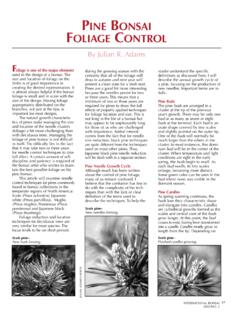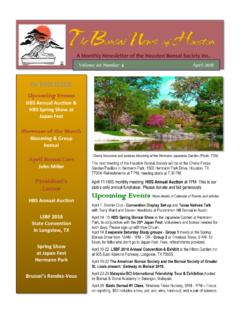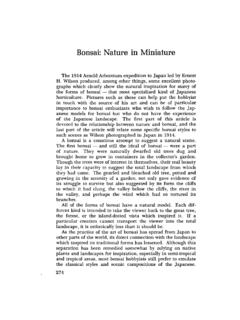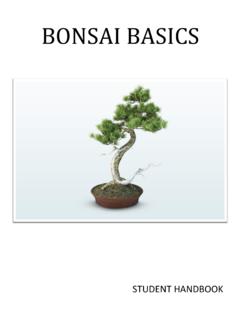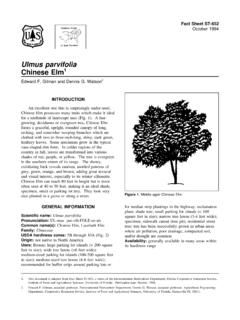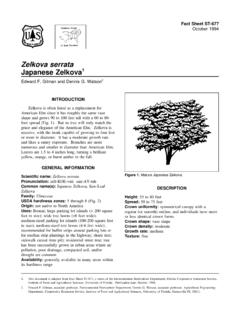Transcription of The story of the Shimpaku juniper Its Secret History
1 The story of the Shimpaku juniper Its Secret History (English Translation WBFF 2003; Original Japanese Text and Photos Kindai Shuppan Co. 2003). Brought at Shohin-Bonsai Europe with permission. It is astonishing to realize that the Shimpaku juniper so beloved for bonsai culture was first found only a little more than a century ago in Japan. But in that short time, due to over collecting, the Shimpaku growing in the wild have vanished! When and where were the Shimpaku discovered? Who collected them from the mountain cliffs and how did they do it? What happened over those 100 years to these collected masterpieces? Do any Japanese bonsai nurseries still have collected Shimpaku for sale today? These and many other secrets about the Shimpaku are revealed in the fascinating article that is being published on this website.
2 This article was written by Kazuki Yamanaka and recently published in Japanese in the June 2003 issue of Kindai Bonsai Magazine. Due to a generous donation from Daizo Iwasaki, WBFF s Vice-Chairman, WBFF obtained permission from the publisher to translate the article into English and publish it on the WBFF website. We thank Ikuyo Shisaka for her sensitive and faithful translation of the original Japanese text into English. The English text has been edited for the benefit of non-Japanese readers and reordered for a more chronological presentation. Chapter I - Discovery of Shimpaku Today, the Shimpaku junipers growing in the wild in Japan face extinction. These junipers are only known to exist on Hokkaido and Yakeshima Islands, and extinction is said to be certain if very strong steps are not taken.
3 The Shimpaku is a variation of Chinese juniper (Juniperus chinensis, or Ibuki or Byaku-shin in Japanese). Its Latin botanical name is Juniperus chinensis sargentii, named after Sargent who identified it on Hokkaido in 1892. The Japanese botanical name of the Shimpaku juniper is Miyama-Byakushin. It belongs to the family CUPRESSACEAE which also includes the Hinoki cypress (Chamaecyparis obtusa). Categorized as a conditional limestone plant, it is also sometimes found in areas rich in the mineral peridot. The tree on the right is called Noble Satake s Shimpaku . It was such a rare specimen that, after it was collected, it was initially named The Smoke of the Volcano. This name described realistically its powerful swirling trunk and Shari.
4 This was one of the best Shimpaku bonsai, but regrettably it died during the devastated period after World War II. Nowadays, because virtually all of the naturally-grown Shimpaku have been exhausted, it is impossible to find a Shimpaku with such character. So many famous trees have been lost, but at the same time many stories about Shimpaku have been born. In Bonsai Gahou (Magazine) No. 5 (September 1907 issue), there is a discussion of the origin of Shimpaku bonsai. It says that in 1889 a bonsai lover, Rokurou Ohta, obtained a juniper bonsai that reminded its admirers of a famous painting of Kanzankokai (an old Japanese cypress in the winter mountain). The rumor spread among the traders that this is the authentic (=shin), oak (=paku).
5 Thus, the juniper was named Shinpaku. (Accounting for the conventions of Japanese word combination, it becomes Shimpaku . ) This word was not known in either the Chinese or Japanese language and so the name Shimpaku was conceived within the world of bonsai as a new variety of junipers. Shimpaku junipers have been popular since the 1890s, but for some time they were appreciated as one of the Kinseijyu group like Rohdea Japonica (Omoto), or were considered too thick and too heavy in appearance. Even so, this juniper has had an extraordinary popularity since its very first appearance. Its popularity gave birth to enthusiastic collectors such as Tason Ohata, and from the beginning almost all the major bonsai lovers devoted themselves wholeheartedly to this juniper .
6 Indeed, by 1900 the Shimpaku juniper became accepted as one of the classic species used in bonsai. During the early years of its popularity, there was an extreme shortage of Shimpaku , particularly compared to the mainstream trees used for bonsai at that time, such as Japanese red pine (Akamatsu) , Japanese black pine (Kuromatsu) and Japanese cedar (Sugi). As a result, you could have boasted of having it whatever the quality. If the Shimpaku was really of high quality, it would cost you a fortune, and the exorbitant price resulting from the rarity of Shimpaku seemed to be its destiny. Many of the best Shimpaku inhabited only inaccessible cliff areas, and thus they were very difficult to collect. Behind the scenes of the brilliant popularity of Shimpaku bonsai, there were collectors risking their lives.
7 Shimpaku , the fascinating tree, has a hidden History which will be revealed in this article. Chapter II - First Shimpaku : Ishizuchi Shimpaku Mt. Ishizuchi is the highest peak on Shikoku island It is said that the first Shimpaku to be collected in the wild came from the Ishizuchi mountain range on Shikoku Island. This is an area in which collectors had, for a long time, obtained Japanese red pine (Akamatsu) and Japanese black pine (Kuromatsu) for use in bonsai. These collectors included experts in mountain collecting who had extensive experience and knowledge of transplanting and growing new roots on collected specimens. It was one of these collectors who found in the mountains for the first time a form of Chinese juniper that would later be called Shimpaku .
8 Chinese junipers grown in pots had been appreciated for a long time. If the Chinese juniper he had found was suitable for pot plantings, he felt he could not miss. Wasting no time, this collector dug up the juniper , transplanted it into a pot, and then brought it to a bonsai trader in the town of Takamatsu, which faces the Seto Inland Sea on the northern coast of Shikoku. At that time, Takamatsu was one of the centers for bonsai material from Shikoku, and traders would come to buy not only from Kyoto, Osaka and Kobe, but from as far away as Tokyo. The Chinese juniper variation that became known as Shimpaku first became popular in the Kansai region, and its popularity soon reached Tokyo. This is because a skillful trader from Kunpu-en Garden made good ones available, which impressed those persons having good taste.
9 Northern Shikoku - showing Takamatsu The golden age of Ishizuchi Shimpaku existed during the Meiji period from around 1868 to 1878. The aesthetic sense of people of that time toward Shimpaku was greatly different from that of today. In a word, they yearned for a taste of the mountains. The Jin and Shari of the Shimpaku were not greatly appreciated; instead, they were deeply impressed by the natural posture of these junipers fostered by their growing in the mountains. Those with extreme twists and turns were not in fashion, but instead they sought those expressing age in a subtle and tasteful manner (shibui). Indeed, the pictures from the Meiji period show that there was almost no trace of branch shaping. They exercised restraint in pruning the Shimpaku as much as possible, and they did not peel off the soft outer bark of these junipers or polish their trunks.
10 Shimpaku bonsai of Meiji Period The way they cherished the Shimpaku was similar to that of antiques. Ishizuchi Shimpaku , compared to Itoigawa Shimpaku which came later, had an untamed but sensitive shape and, since they could just be planted in a pot and be appreciated, they became very popular. Many were of medium size and thus were perfectly suitable for bonsai. Shikoku Shimpaku bonsai were appreciated for aged trunks with not too much movement. Chapter III - Collecting Ishizuchi Shimpaku At the beginning of their popularity, Shimpaku were everywhere in the Ishizuchi mountain range and one did not need many tools. Many Shimpaku could be found and were easily dug up. As the demand for Shimpaku heightened, excessive collecting began to occur.
